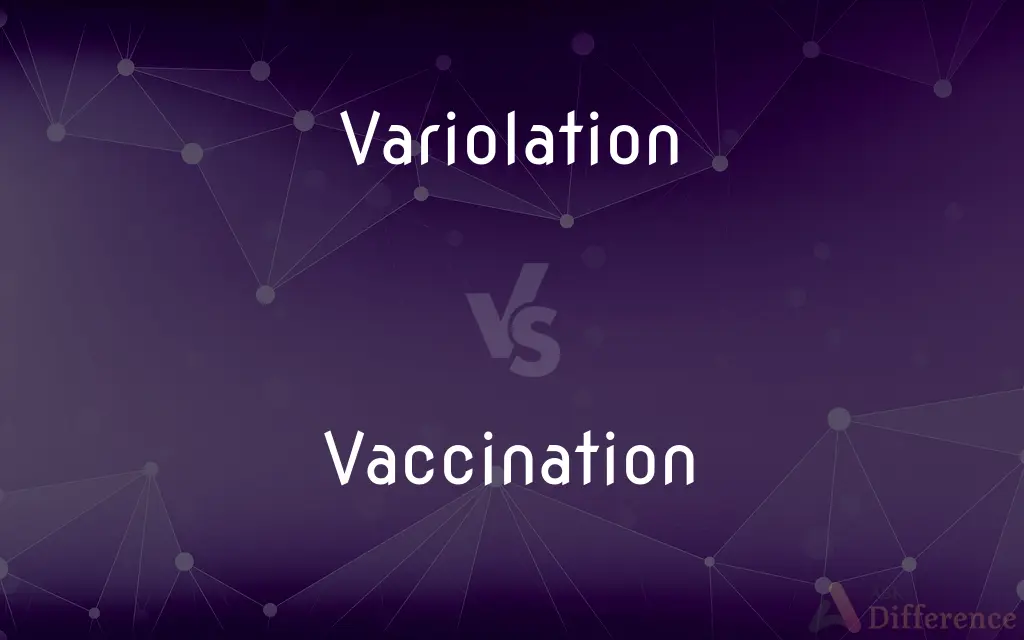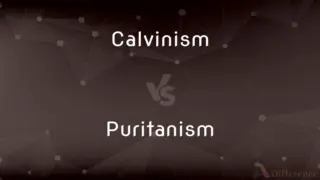Variolation vs. Vaccination — What's the Difference?
By Tayyaba Rehman & Fiza Rafique — Updated on March 3, 2024
Variolation was an early method to induce immunity against smallpox by exposing individuals to material from smallpox sores, while vaccination involves administering a vaccine to stimulate an immune response without causing the disease.

Difference Between Variolation and Vaccination
Table of Contents
ADVERTISEMENT
Key Differences
Variolation specifically refers to the practice used before the development of vaccines, where material from smallpox lesions was introduced into the skin of a non-immune individual. This process aimed to elicit a mild form of the disease, thereby inducing immunity against smallpox. Whereas vaccination is a broader term that encompasses the administration of a vaccine, which can be a weakened or killed form of the pathogen, its toxins, or one of its surface proteins, to stimulate the body's adaptive immunity and prepare it to fight future infections by the same pathogen.
Variolation had a significant risk associated with it, as it involved the deliberate introduction of a dangerous pathogen into the body, potentially leading to severe disease. On the other hand, vaccination is designed to be much safer, using formulations that have been developed to minimize the risk of inducing the disease they aim to prevent. Modern vaccines undergo rigorous testing to ensure their safety and efficacy.
The practice of variolation was a precursor to the concept of vaccination and was widespread in several ancient cultures, including China, Africa, and India, before it was introduced to Europe in the 18th century. Vaccination, however, began with the work of Edward Jenner in 1796, who used cowpox material to create immunity against smallpox, marking the start of the modern era of immunization practices.
While variolation was effective to some degree in preventing smallpox, it was not without its flaws, notably the risk of spreading the disease. Vaccination has since evolved to include a wide range of diseases beyond smallpox, such as polio, measles, and influenza, employing various technologies including live attenuated and inactivated pathogens, as well as mRNA vaccines.
The transition from variolation to vaccination represented a significant advancement in public health, reducing the incidence of vaccine-preventable diseases dramatically. Vaccines have become an essential tool in global health and eradicating diseases like smallpox.
ADVERTISEMENT
Comparison Chart
Definition
Introduction of material from smallpox sores
Administration of a vaccine to stimulate immunity
Risk
High, with potential to cause disease
Low, designed to minimize disease induction
Historical Origin
Ancient practices in China, Africa, and India
Developed by Edward Jenner in 1796
Pathogen Type
Live variola virus
Weakened/killed pathogens, toxins, or proteins
Scope
Primarily smallpox
Wide range of diseases
Compare with Definitions
Variolation
A procedure for immunization against smallpox using material from smallpox sores.
In the 18th century, variolation was a common method to confer immunity to smallpox.
Vaccination
The process of administering a vaccine to stimulate an immune response.
Vaccination against measles has significantly reduced its incidence.
Variolation
Practiced in ancient cultures.
Variolation was known in ancient China as a way to fight smallpox.
Vaccination
Can prevent a wide range of diseases.
Vaccination programs now include diseases like influenza, HPV, and hepatitis B.
Variolation
Involved deliberate infection.
Variolation intentionally infected individuals with smallpox material.
Vaccination
Designed to be safe and effective.
Modern vaccination protocols undergo rigorous testing for safety.
Variolation
Early form of immunization before vaccines.
Variolation exposed individuals directly to the variola virus to prevent smallpox.
Vaccination
Uses weakened or killed forms of pathogens.
Polio vaccination employs an attenuated virus to induce immunity.
Variolation
Risk of spreading disease.
Variolation carried the risk of initiating a smallpox outbreak.
Vaccination
Essential for public health.
Vaccination has been pivotal in eradicating smallpox globally.
Variolation
Variolation was the method of inoculation first used to immunize individuals against smallpox (Variola) with material taken from a patient or a recently variolated individual, in the hope that a mild, but protective, infection would result. The procedure was most commonly carried out by inserting/rubbing powdered smallpox scabs or fluid from pustules into superficial scratches made in the skin.
Vaccination
Vaccination is the administration of a vaccine to help the immune system develop protection from a disease. Vaccines contain a microorganism or virus in a weakened, live or killed state, or proteins or toxins from the organism.
Variolation
(historical) The inoculation of a person with smallpox with the intention of inducing a mild form of the illness and subsequent immunity to the disease.
Variolation is no longer used today. It was replaced by smallpox vaccination, a safer alternative, which in turn led to the development of vaccines against many other diseases.
Vaccination
Treatment with a vaccine to produce immunity against a disease; inoculation
If you think you need a flu vaccination, check with your doctor
Vaccination against yellow fever is essential
Variolation
Inoculation with smallpox.
Vaccination
Inoculation with a vaccine in order to protect against a particular disease.
Variolation
The obsolete process of inoculating a susceptible person with material taken from a vesicle of a person who has smallpox
Vaccination
Inoculation with a vaccine, in order to protect from a particular disease or strain of disease.
Vaccination
The act, art, or practice of vaccinating, or inoculating with the cowpox, in order to prevent or mitigate an attack of smallpox. Cf. Inoculation.
Common Curiosities
How does vaccination differ from variolation?
Vaccination involves administering a vaccine to stimulate the immune system without causing the disease, unlike variolation, which used live smallpox material.
What risks were associated with variolation?
Variolation carried a significant risk of causing severe disease due to the use of live smallpox virus.
Why is vaccination important?
Vaccination is crucial for preventing infectious diseases, saving millions of lives, and eradicating diseases like smallpox.
What is variolation?
Variolation was a method of inducing immunity against smallpox by exposing individuals to material from smallpox sores.
Are vaccines safe?
Yes, vaccines undergo extensive research and testing to ensure they are safe and effective.
Was variolation practiced worldwide?
Variolation was practiced in several ancient cultures, including in China, Africa, and India, before spreading to Europe.
How did vaccination evolve from variolation?
Vaccination, developed by Edward Jenner using cowpox material, evolved as a safer method to induce immunity against smallpox, eventually expanding to other diseases.
Can vaccination prevent diseases other than smallpox?
Yes, vaccination can prevent a wide range of diseases, including polio, measles, influenza, and many others.
What makes vaccines effective?
Vaccines stimulate the immune system to recognize and fight pathogens without causing the disease.
What types of vaccines are there?
There are several types, including live attenuated, inactivated, subunit, and mRNA vaccines.
What is the scope of vaccination today?
Modern vaccination covers a broad range of diseases, significantly reducing the incidence of vaccine-preventable illnesses.
How did Edward Jenner contribute to vaccination?
Edward Jenner's development of the smallpox vaccine using cowpox material marked the beginning of modern vaccination practices.
What were the limitations of variolation?
Variolation's main limitations were the risk of disease transmission and the potential for severe infection.
How has vaccination impacted public health?
Vaccination has dramatically improved public health, reducing the prevalence of many infectious diseases.
Can vaccination lead to disease eradication?
Yes, successful vaccination campaigns can lead to the eradication of diseases, as seen with smallpox.
Share Your Discovery

Previous Comparison
Boutique vs. Shop
Next Comparison
Calvinism vs. PuritanismAuthor Spotlight
Written by
Tayyaba RehmanTayyaba Rehman is a distinguished writer, currently serving as a primary contributor to askdifference.com. As a researcher in semantics and etymology, Tayyaba's passion for the complexity of languages and their distinctions has found a perfect home on the platform. Tayyaba delves into the intricacies of language, distinguishing between commonly confused words and phrases, thereby providing clarity for readers worldwide.
Co-written by
Fiza RafiqueFiza Rafique is a skilled content writer at AskDifference.com, where she meticulously refines and enhances written pieces. Drawing from her vast editorial expertise, Fiza ensures clarity, accuracy, and precision in every article. Passionate about language, she continually seeks to elevate the quality of content for readers worldwide.
















































